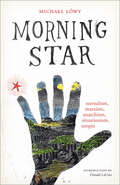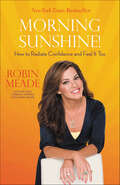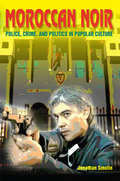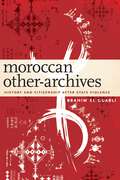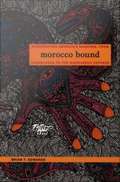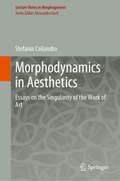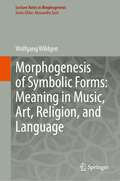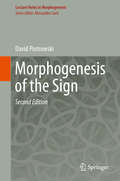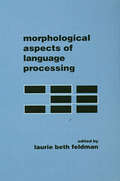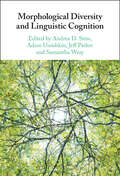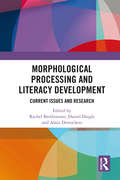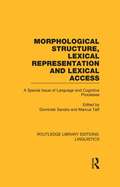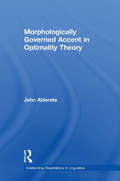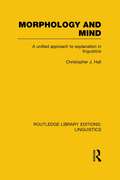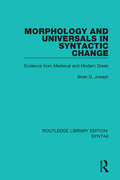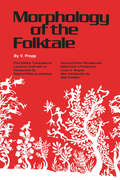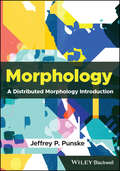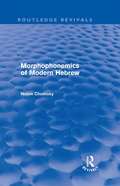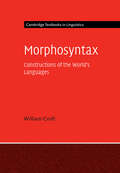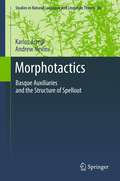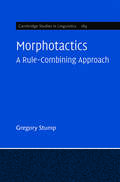- Table View
- List View
Morning Star: Surrealism, Marxism, Anarchism, Situationism, Utopia (Surrealist Revolution Series)
by Michael LöwyAn expanded edition of revered theorist Michael Löwy’s Morning Star: Marxism and Surrealism (previously published in French, Portuguese, Spanish, Italian, and Greek), this masterwork collects the author’s essays on the ways in which surrealism intersected with a variety of revolutionary political approaches, ranging from utopian ideals to Marxism and situationism. Taking its title from André Breton’s essay “Arcane 17,” which casts the star as the searing firebrand of rebellion, Löwy’s provocative work spans many perspectives. These include surrealist artists who were deeply interested in Marxism and anarchism (Breton among them), as well as Marxists who were deeply interested in surrealism (Walter Benjamin in particular). Probing the dialectics of innovation, diversity, continuity, and unity throughout surrealism’s international presence, Morning Star also incorporates analyses of Claude Cahun, Guy Debord, Pierre Naville, José Carlos Mariátegui and others, accompanied by numerous reproductions of surrealist art. An extraordinarily rich collection, Morning Star promises to ignite new dialogues regarding the very nature of dissent.
Morning Sunshine!: How to Radiate Confidence and Feel It Too
by Robin MeadeRobin Meade is the poster child for confidence and self-assurance. But the anchor of Morning Express with Robin Meade wasn't always that way. In fact, there was a period in her career when she was plagued with anxiety and panic attacks. In MORNING SUNSHINE, she tells how she overcame her fear of public speaking to go on and achieve her dream of becoming a news anchor. Robin Meade offers her own tried-and-true four-step approach to building confidence. Her trademark warm, personal style translates from the screen to the page in this book, which will give readers even more insight into the young woman who came out of nowhere to become one of the most popular news anchors on television today.
Morning, Noon, and Night: Finding the Meaning of Life's Stages Through Books
by Arnold WeinsteinFrom Homer and Shakespeare to Toni Morrison and Jonathan Safran Foer, major works of literature have a great deal to teach us about two of life's most significant stages--growing up and growing old. Distinguised scholar Arnold Weinstein's provocative and engaging new book, Morning, Noon, and Night, explores classic writing's insights into coming-of-age and surrendering to time, and considers the impact of these revelations upon our lives. With wisdom, humor, and moving personal observations, Weinstein leads us to look deep inside ourselves and these great books, to see how we can use art as both mirror and guide. He offers incisive readings of seminal novels about childhood-Huck Finn's empathy for the runaway slave Jim illuminates a child's moral education; Catherine and Heathcliff's struggle with obsessive passion in Wuthering Heights is hauntingly familiar to many young lovers; Dickens's Pip, in Great Expectations, must grapple with a world that wishes him harm; and in Marjane Satrapi's autobiographical Persepolis, little Marjane faces a different kind of struggle--growing into adolescence as her country moves through the pain of the Iranian Revolution. In turn, great writers also ponder the lessons learned in life's twilight years: both King Lear and Willy Loman suffer as their patriarchal authority collapses and death creeps up; Brecht's Mother Courage displays the inspiring indomitability of an aging woman who has "borne every possible blow... but is still standing, still moving." And older love can sometimes be funny (Rip Van Winkle conveniently sleeps right through his marriage) and sometimes tragic (as J. M. Coetzee's David Lurie learns the hard way, in Disgrace). Tapping into the hearts and minds of memorable characters, from Sophocles' Oedipus to Artie in Art Spiegelman's Maus, Morning, Noon, and Night makes an eloquent and powerful case for the role of great literature as a knowing window into our lives and times. Its intelligence, passion, and genuine appreciation for the written word remind us just how crucial books are to the business of being human.
Moroccan Noir
by Jonathan SmolinFacing rising demands for human rights and the rule of law, the Moroccan state fostered new mass media and cultivated more positive images of the police, once the symbol of state repression, reinventing the relationship between citizen and state for a new era. Jonathan Smolin examines popular culture and mass media to understand the changing nature of authoritarianism in Morocco over the past two decades. Using neglected Arabic sources including crime tabloids, television movies, true-crime journalism, and police advertising, Smolin sheds new light on politics and popular culture in the Middle East and North Africa.
Moroccan Other-Archives: History and Citizenship after State Violence
by Brahim El GuabliWinner, 2024 L. Carl Brown AIMS Book Prize in North African StudiesHonorable Mention, 2024 MELA Book AwardsFinalist, 2024 ASA Best Book PrizeMoroccan Other-Archives investigates how histories of exclusion and silencing are written and rewritten in a postcolonial context that lacks organized and accessible archives. The book draws on cultural production concerning the “years of lead”—a period of authoritarianism and political violence between Morocco’s independence in 1956 and the death of King Hassan II in 1999—to examine the transformative roles memory and trauma play in reconstructing stories of three historically marginalized groups in Moroccan history: Berbers/Imazighen, Jews, and political prisoners.The book shows how Moroccan cultural production has become an other-archive: a set of textual, sonic, embodied, and visual sites that recover real or reimagined voices of these formerly suppressed and silenced constituencies of Moroccan society. Combining theoretical discussions with close reading of literary works, the book reenvisions both archives and the nation in postcolonial Morocco. By producing other-archives, Moroccan cultural creators transform the losses state violence inflicted on society during the years of lead into a source of civic engagement and historiographical agency, enabling the writing of histories about those Moroccans who have been excluded from official documentation and state-sanctioned histories.The book is multilingual and interdisciplinary, examining primary sources in Amazigh/Berber, Arabic, Darija, and French, and drawing on memory studies, literary theory, archival studies, anthropology, and historiography. In addition to showing how other-archives are created and operate, El Guabli elaborates how language, gender, class, race, and geographical distribution are co-constitutive of a historical and archival unsilencing that is foundational to citizenship in Morocco today.
Morocco Bound: Disorienting America's Maghreb, from Casablanca to the Marrakech Express
by Brian T. EdwardsUntil attention shifted to the Middle East in the early 1970s, Americans turned most often toward the Maghreb--Morocco, Algeria, Tunisia, and the Sahara--for their understanding of "the Arab. " In Morocco Bound, Brian T. Edwards examines American representations of the Maghreb during three pivotal decades--from 1942, when the United States entered the North African campaign of World War II, through 1973. He reveals how American film and literary, historical, journalistic, and anthropological accounts of the region imagined the role of the United States in a world it seemed to dominate at the same time that they displaced domestic social concerns--particularly about race relations--onto an "exotic" North Africa. Edwards reads a broad range of texts to recuperate the disorienting possibilities for rethinking American empire. Examining work by William Burroughs, Jane Bowles, Ernie Pyle, A. J. Liebling, Jane Kramer, Alfred Hitchcock, Clifford Geertz, James Michener, Ornette Coleman, General George S. Patton, and others, he puts American texts in conversation with an archive of Maghrebi responses. Whether considering Warner Brothers' marketing of the movie Casablanca in 1942, journalistic representations of Tangier as a city of excess and queerness, Paul Bowles's collaboration with the Moroccan artist Mohammed Mrabet, the hippie communities in and around Marrakech in the 1960s and early 1970s, or the writings of young American anthropologists working nearby at the same time, Edwards illuminates the circulation of American texts, their relationship to Maghrebi history, and the ways they might be read so as to reimagine the role of American culture in the world.
Morphodynamics in Aesthetics: Essays on the Singularity of the Work of Art (Lecture Notes in Morphogenesis)
by Stefania CaliandroThis book deals with the complexity of art by focusing on the singularity of the work of art. Gathering a selection of writings in art theory and semiotics, it explores the question of apprehending art from its perceptual aspects to aesthetic comprehension and understanding. Theoretical enquiries focus in particular on the dynamics of the perception of forms, the semiotic value of colour, the aesthetic phenomenon of empathy, the function of vision in relation to other senses and its faculty to lead, in a substantial way, to the embodiment of sense. These theoretical points are constantly observed with reference to the analysis of works of art, especially from the beginning of the modern era, when a renovated psychophysical approach oriented the evolution of contemporary aesthetics. Research into art theories sheds light on how differentials in topologic positions, dimensions, relationships and tones contribute to the arising of forms and colours in perception, and affect the perceiver. The essays presented address in different ways the emergence of sense, by conceiving it as deeply anchored to the dynamics of perception, in addition to the cognitive disposition and knowledge, regardless of whether or not the subject (artist or beholder) is aware of these processes. Through in-depth analyses identifying to what extent the aesthetic moment builds on perceptual and semiotic processes, works of art are revealed to be singularities, reflecting the correlation with morphodynamics in the sciences.
Morphogenesis of Symbolic Forms: Meaning in Music, Art, Religion, and Language (Lecture Notes in Morphogenesis)
by Wolfgang WildgenIn the present book, the starting line is defined by a morphogenetic perspective on human communication and culture. The focus is on visual communication, music, religion (myth), and language, i.e., on the “symbolic forms” at the heart of human cultures (Ernst Cassirer). The term “morphogenesis” has more precisely the meaning given by René Thom (1923-2002) in his book “Morphogenesis and Structural Stability” (1972) and the notions of “self-organization” and cooperation of subsystems in the “Synergetics” of Hermann Haken (1927- ). The naturalization of communication and cultural phenomena is the favored strategy, but the major results of the involved disciplines (art history, music theory, religious science, and linguistics) are respected.Visual art from the Paleolithic to modernity stands for visual communication. The present book focuses on studies of classical painting and sculpture (e.g., Leonardo da Vinci, William Turner, and Henry Moore) and modern art (e.g., Jackson Pollock and Joseph Beuys). Musical morphogenesis embraces classical music (from J. S. Bach to Arnold Schönberg) and political songwriting (Bob Dylan, Leonhard Cohen). The myths of pre-literary societies show the effects of self-organization in the re-assembly (bricolage) of traditions. Classical polytheistic and monotheistic religions demonstrate the unfolding of basic germs (religious attractors) and their reduction in periods of crisis, the self-organization of complex religious networks, and rationalized macro-structures (in theologies). Significant tendencies are analyzed in the case of Buddhism and Christianism. Eventually, a holistic view of symbolic communication and human culture emerges based on state-of-the-art in evolutionary biology, cognitive science, linguistics, and semiotics (philosophy of symbolic forms).
Morphogenesis of the Sign: From Morphodynamics To Neurosciences (Lecture Notes in Morphogenesis)
by David PiotrowskiThis book develops a morphodynamical approach to linguistic and sign structures as an integrated response to multilevel and interrelated problems in semiolinguistic research. More broadly, the content is linked to the realities of living speech through a connection (via the concept of diacriticity) with the Merleau-Pontian phenomenology, and beyond the formal determinations of a semiolinguistic system and its calculus. Such problems are mainly epistemological (concerning the nature and legitimate scope of semiolinguistic knowledge), empirical (concerning the observational device and the data’s composition), and theoretical (regarding the choice of a conceptual and formalized explicative frame). With regard to theory, the book introduces a morphodynamical architecture of linguistic signs and operations as a suitable mathematization of Saussurean theory. The Husserlian phenomenological signification of this formal apparatus is then established, and, from an empirical standpoint, its compatibility with neurobiological experimental results is discussed.
Morphological Aspects of Language Processing
by Laurie Beth FeldmanIt is now well established that phonological -- and orthographic -- codes play a crucial role in the recognition of isolated words and in understanding the sequences of words that comprise a sentence. However, words and sentences are organized with respect to morphological as well as phonological components. It is thus unfortunate that the morpheme has received relatively little attention in the experimental literature, either from psychologists or linguists. Due to recent methodological developments, however, now is an opportune time to address morphological issues. In the experimental literature, there is a tendency to examine various psycholinguistic processes in English and then to assume that the account given applies with equal significance to English and to other languages. Written languages differ, however, in the extent to which they capture phonological as contrasted with morphological units. Moreover, with respect to the morpheme, languages differ in the principle by which morphemes are connected to form new words. This volume focuses on morphological processes in word recognition and reading with an eye toward comparing morphological processes with orthographic and phonological processes. Cross-language comparisons are examined as a tool with which to probe universal linguistic processes, and a variety of research methodologies are described. Because it makes the experimental literature in languages other than English more accessible, this book is expected to be of interest to many readers. It also directs attention to the subject of language processing in general -- an issue which is of central interest to cognitive psychologists and linguists as well as educators and clinicians.
Morphological Diversity and Linguistic Cognition
by Jeff Parker Andrea D. Sims Adam Ussishkin Samantha WrayMorphological structures interact dynamically with lexical processing and storage, with the parameters of morphological typology being partly dependent on cognitive pathways for processing, storage and generalization of word structure, and vice versa. Bringing together a team of well-known scholars, this book examines the relationship between linguistic cognition and the morphological diversity found in the world's languages. It includes research from across linguistic and cognitive science sub-disciplines that looks at the nature of typological diversity and its relationship to cognition, touching on concepts such as complexity, interconnectedness within systems, and emergent organization. Chapters employ experimental, computational, corpus-based and theoretical methods to examine specific morphological phenomena, and an overview chapter provides a synthesis of major research trends, contextualizing work from different methodological and philosophical perspectives. Offering a novel perspective on how cognition contributes to our understanding of word structure, it is essential reading for psycholinguists, theoreticians, typologists, computational modelers and cognitive scientists.
Morphological Processing and Literacy Development: Current Issues and Research
by Alain Desrochers Rachel Berthiaume Daniel DaigleSynthesizing a range of studies on morphological processing from the past 30 years, this edited collection presents the current state of knowledge on morphological processing and defines classroom practices to help students conceptualise the role of morphology in reading, spelling, and vocabulary development. Research has increasingly indicated the importance of morphological tasks in relation to reading, spelling, and vocabulary acquisition in the classroom. Chapter authors present the theoretical considerations guiding morphological processing research to date, address the use of morphology with reference to different populations of learners, and propose effective and innovative instructional strategies for integrating morphology in the classroom.
Morphological Structure, Lexical Representation and Lexical Access: A Special Issue of Language and Cognitive Processes (Routledge Library Editions: Linguistics)
by Dominiek Sandra Marcus TaftThe main concern of this work is whether morphemes play a role in the lexical representation and processing of several types of polymorphemic words and, more particularly, at what precise representational and processing level. The book comprises two theoretical contributions and a number of empirical ones. One theoretical paper discusses several possible motivations for a morphologically organised mental lexicon (like the economy of representation view, and the efficiency of processing view), and lays out the weaknesses that are associated with some of these motivations. The other theoretical paper offers an interactive-activation reinterpretation of the findings that were originally reported within the lexical search framework. The empirical papers together cover a relatively broad array of language types and mainly deal with visual word recognition in normals in the context of lexical morphology (derived and compound words). Evidence is reported on the function of stems and affixes as processing units in prefixed and suffixed derivations. The role of semantic transparency in the lexical representation of compounds is studied, as is the effect of orthographic ambiguity on the parsing of novel compounds. The inflection-derivational distinction is approached in the context of Finnish, a highly agglutinative language with much richer morphology than the languages usually studied in psycholinguistic experiments on polymorphemic words. Two other contributions also approach the study object in the context of relatively uncharted domains: one presents data on Chinese, a language which uses a different script-type (logographic) from the languages that are usually studied (alphabetic script), and another one presents data on language production.
Morphological Typology
by Gregory Stump Raphael A. FinkelIn this radically new approach to morphological typology, the authors set out new and explicit methods for the typological classification of languages. Drawing on evidence from a diverse range of languages, including Chinantec, Dakota, French, Fur, Icelandic, Ngiti and Sanskrit, the authors propose innovative ways of measuring inflectional complexity. Designed to engage graduate students and academic researchers, the book presents opportunities for further investigation. Readers can also access an online computational tool designed by the authors to conduct further analysis on data sets.
Morphologically Governed Accent in Optimality Theory (Outstanding Dissertations in Linguistics)
by John D. AldereteAlderete examines the influences of morphological factors on stress and pitch accent within Optimality Theory.
Morphology and Mind: A Unified Approach to Explanation in Linguistics (Routledge Library Editions: Linguistics)
by Christopher J. HallThe central concern of this book is the explanation of linguistic form. It examines in detail certain cross-linguistic patterns in morphological systems, providing unified explanations of the observation that suffixes predominate over prefixes and the correlation between affix position and syntactic head position. The explanation of the suffixing preference is one which appeals to principles of language processing, tempered by cognitive constraints underlying language change. These factors, coupled with generative morphological analysis, also provide an explanation for the head/affix correlation. The extended case-study illustrates a unified, integrative approach to explanation in linguistics which stresses two major features: the search for cognitive or other functional principles that could potentially underlie formally specified regularities; and the need for a micro-analysis of the mechanisms of ‘linkage’ between regularity and explanation. The natural methodological consequence of such an approach is a move towards greater cooperation between the various subdisciplines of linguistics, as well as a greatly needed expansion of cross-disciplinary research. The author’s broad training in theoretical morphology, formal and typological universals, and language processing, allows him to cross traditional boundaries and view the complex interactions between theoretical linguistic principles and cognitive mechanisms with considerable clarity of vision.
Morphology and Universals in Syntactic Change: Evidence from Medieval and Modern Greek (Routledge Library Editions: Syntax #12)
by Brian D. JosephThis book, first published in 1990, is a study of both the specific syntactic changes in the more recent stages of Greek and of the nature of syntactic change in general. Guided by the constraints and principles of Universal Grammar, this hypothesis of this study allows for an understanding of how these changes in Greek syntax occurred and so provides insight into the mechanism of syntactic change. This title will be of interest to students of language and linguistics.
Morphology of the Folk Tale: Second Edition
by V. ProppThis seminal work by the renowned Russian folklorist presents his groundbreaking structural analysis of classic fairytales and their genres.One of the most influential works of 20th century literary criticism, Vladimir Propp&’s Morphology of the Folk Tale is essential reading for anyone interested in examining the structural characteristics of fairytales. Since it first appeared in English in 1958, this groundbreaking study has had a major impact on the work of folklorists, linguists, anthropologists, and literary critics.&“Propp&’s work is seminal…[and], now that it is available in a new edition, should be even more valuable to folklorists who are directing their attention to the form of the folktale, especially those structural characteristics which are common to many entries coming from different cultures.&”—Choice
Morphology of the Folktale: Second Edition
by V. ProppMorphology will in all probability be regarded by future generations as one of the major theoretical breakthroughs in the field of folklore in the twentieth century. -- Alan Dundes Propp's work is seminal. . . and], now that it is available in a new edition, should be even more valuable to folklorists who are directing their attention to the form of the folktale, especially to those structural characteristics which are common to many entries coming from even different cultures. -- Choice
Morphology: A Distributed Morphology Introduction
by Jeffrey P. PunskeThe first comprehensive morphology textbook written in the framework of Distributed Morphology, firmly grounded in cross-linguistic theory Distributed Morphology is the theoretical framework that views morphology as syntactic, proposing that there is no divide between the construction of words and the construction of sentences. The first text of its kind, Morphology: A Distributed Morphology Introduction provides a thorough overview of Distributed Morphology using data and problem sets from a diverse selection of the world's languages. Divided into two parts, this valuable resource begins by describing the basics of morphology and then moves into an exploration of more advanced topics in morphology including morphosyntactic operations, cyclic derivation, the Mirror Principle, and non-compositional language. Each chapter includes a glossary of key terms, learning objectives, further readings, and illustrative examples to reinforce learning. Exercises and problem sets encourage students to develop their understanding and build confidence in the application of theory to practice. Through this valuable text, students will develop comprehension in morphological parsing and glossing, the concept of the lexicon, the different types of morphemes, the idea of paradigms, the basic practice of morphological analysis, and more. Offering detailed yet accessible coverage of morphological theory from the perspective of Distributed Morphology, this textbook: Introduces the methodology used in morphology, the basic assumptions of Distributed Morphology, and key concepts from lexical grammatical approaches to language Covers essential phonology, feature interaction, paradigms as linguistic objects, core ideas of syntax and syntactic derivation, and derivation and inflection in Distributed Morphology Includes a Quick Reference Guide with glossing abbreviations from the Leipzig Glossing Rules, a full IPA chart with instructions, and charts of phonological features Provides access to a companion website containing solutions to problem sets and additional instructor resources Morphology: A Distributed Morphology Introduction is the ideal textbook for advanced undergraduates and graduate students in morphology courses or with an interest in specializing in morphology. Offering students an unparalleled overview of this growing field of morphology, this text will ensure that developing morphologists are well-equipped to employ the latest methods in Distributed Morphology to their own research and study.
Morphophonemics of Modern Hebrew (Routledge Revivals)
by Noam ChomskyRoutledge Revivals presents a reissue of Noam Chomksy’s MA thesis, written in 1951, and first published in 1979. Morphophonemics of Modern Hebrew is a landmark study in linguistics and generative phonology, which provides not only an analysis of morphophonemics but of the entire grammar of Modern Hebrew from syntax to phonology. Professor Chomsky’s goal in this thesis is nothing less than a complete generative grammar of the Hebrew language. This work is of singular importance as it contains the genesis of the author’s work in the field of generative grammar which has had such a profound impact upon the study of linguistics. This reissue of a truly pioneering work will be of great interest to all those concerned with generative grammar and its origins, and with the progression of thought of one of the greatest minds of our time.
Morphosyntactic Change
by Marion Elenbaas Geert Booij Bettelou Los Corrien Blom Ans Van KemenadeParticle verbs (combinations of two words but lexical units) are a notorious problem in linguistics. Is a particle verb like look up one word or two? It has its own entry in dictionaries, as if it is one word, but look and up can be split up in a sentence: we can say He looked the information up and He looked up the information. But why can't we say He looked up it? In English look and up can only be separated by a direct object, but in Dutch the two parts can be separated over a much longer distance. How did such hybrid verbs arise and how do they function? How can we make sense of them in modern theories of language structure? This book sets out to answer these and other questions, explaining how these verbs fit into the grammatical systems of English and Dutch.
Morphosyntax: Constructions of the World's Languages (Cambridge Textbooks in Linguistics)
by William CroftBringing together the results of sixty years of research in typology and universals, this textbook presents a comprehensive survey of Morphosyntax - the combined study of syntax and morphology. Languages employ extremely diverse morphosyntactic strategies for expressing functions, and Croft provides a comprehensive functional framework to account for the full range of these constructions in the world's languages. The book explains analytical concepts that serve as a basis for cross-linguistic comparison, and provides a rich source of descriptive data that can be analysed within a range of theories. The functional framework is useful to linguists documenting endangered languages, and those writing reference grammars and other descriptive materials. Each technical term is comprehensively explained, and cross-referenced to related terms, at the end of each chapter and in an online glossary. This is an essential resource on Morphosyntax for advanced undergraduate and graduate students, researchers, and linguistic fieldworkers.
Morphotactics
by Andrew Nevins Karlos ArregiThis comprehensive treatment of several phenomena in Distributed Morphology explores a number of topics of high relevance to current linguistic theory. It examines the structure of the syntactic and postsyntactic components of word formation, and the role of hierarchical, featural, and linear restrictions within the auxiliary systems of several varieties of Basque. The postsyntactic component is modeled as a highly articulated system that accounts for what is shared and what exhibits variation across Basque dialects. The emphasis is on a principled ordering of postsyntactic operations based on their intrinsic properties, and on the relationship between representations in the Spellout component of grammar with other grammatical modules. The analyses in the book treat related phenomena in other languages and thereby have much to offer for a general morphology readership, as well as those interested in the syntax-morphology interface, the theory of Distributed Morphology, and Basque.
Morphotactics: A Rule-Combining Approach (Cambridge Studies in Linguistics #169)
by Gregory StumpThe study of morphology is central to linguistics, and morphotactics – the general principles by which the parts of a word form are arranged – is essential to the study of morphology. Drawing on evidence from a range of languages, this is a comprehensive and up-to-date account of the principles of morphotactic analysis. Stump proposes that the arrangement of word forms' grammatically significant parts is an expression of the ways in which a language's morphological rules combine with one another to form more specific rules. This rule-combining approach to morphotactics has important implications for the synchronic analysis of both inflectional and derivational morphology, and it provides a solid conceptual platform for understanding both the processing of morphologically complex words and the paths of morphological change. Laying the groundwork for future research on morphotactic analysis, this is essential reading for researchers and graduate students in linguistics, and anyone interested in understanding language structure.
